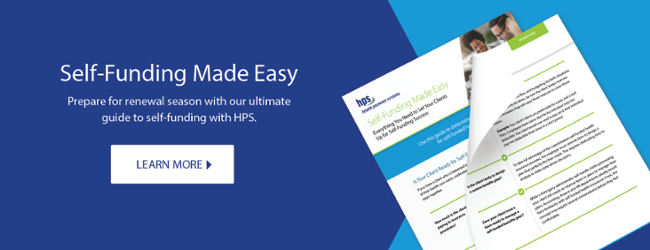
Self-funded plans are employer-provided coverage not purchased from a carrier (i.e., you pay the claims yourself). The employer assumes a higher risk, which is offset by a greater potential for savings than with fully-funded plans.
Making the move from fully-insured to self-funded health insurance can feel like a big step for your clients. You want to make sure that they’re prepared for the responsibilities before selling them on the savings. Below are some questions you need to ask before deciding whether self-funding is right for your client.
What’s the difference between fully-insured and self-funded? Download the guide to learn more.
How much is your client paying in insurance premiums?
While many employers appreciate the flexibility that self-funding provides, what they ultimately want is cost-savings.
Compare the client’s current premium to an estimate of costs related to self-funding (stop-loss insurance premium, third-party administrator costs, etc.). Remember that by self-funding, employers avoid paying the majority of taxes related to benefit plans.
Are claims costs consistent?
When helping clients determine whether self-funded health insurance is right for them, it helps to look at their current claims data. Ideally, the client will have a history of steady claims costs. Predictable claims make it easy for employers to budget for healthcare costs.
Strong candidates have a consistent loss ratio—the total losses incurred in claims plus adjustment expenses divided by the total premiums earned. The goal of self-funding is to ultimately save the client money, so it has to make sense for the employer’s budget and the employees’ healthcare utilization.
Can your client absorb changes in spending changes?
While consistency is key, things happen. Your client needs enough cash flow to absorb variations in spending.
For example, a company’s claims could be predictable for a year and a half. But then, 3 employees could have claims that hit the individual stop-loss deductible and the employer is out $300,000 in a short period of time. It’s important for an employer to be strong enough financially to absorb these costs.
Is the client ready to design a custom benefits plan?
Self-funded plans offer more flexibility than fully-insured plans. To take full advantage, the employer must dedicate time to designing a plan that perfectly fits their needs. This often requires making data-driven decisions. As their broker, you can offer your expertise to maximize both coverage and cost savings.
Some of the customizations employers can make include:
- Number of service tiers available to employees
- Whether to limit certain services (e.g. chiropractor, nutritionist)
- Which wellness program(s) to adopt
- Which specialty drugs to cover
- Whether to offer tax-advantaged accounts
Will your client build a team to manage their benefits plan?
While a third-party administrator will handle claims processing, your client still needs an internal team in place to manage their plans. Ideal candidates include representatives from the accounting/finance and human resources departments.
Human resources plays an especially important role. HR runs information between the TPA and the finance department. They are also most often involved with wellness programs.
Is your client willing to implement consumer and wellness programs?
With self-funding, employers are much more incentivized to put wellness programs and consumer advocacy programs in place. Having a healthy workforce with the right tools to seek affordable healthcare will help lower costs for employers.
Many companies utilize wellness programs when fully insured, but it’s insurance carriers who reap the benefits of companies’ hard work. Self-funded employers looking to further lower costs can use programming to teach their employees to be better healthcare consumers, thereby creating a healthier workforce and saving money.


